
- Home
- >
News
The UV resistance of an outdoor hot bathtub mainly depends on the materials used. High-quality hot water tub outdoor manufacturers usually choose materials with excellent UV resistance. These materials include high-density polyethylene, acrylic and other UV-resistant formulations. These materials mitigate the negative effects of UV rays on color and appearance.
A hot tub is a large bathtub filled with water, used for hydrotherapy, relaxation, or entertainment. Some have powerful jets for massage purposes. Hot tubs are sometimes referred to as "spa centers" or trademarked as massage tubs. In ancient Rome, people discovered the health benefits of hot springs and began bathing in natural hot springs to relax their body and mind. This tradition laid the foundation for the development of hot tubs.
In cold winter weather conditions, the water in a hot tub is prone to freezing. If not handled in a timely manner or preventive measures are taken, the phenomenon of freezing may cause damage to the pipes, water pumps, and other equipment of the hot tub, and even cause more serious accidents. This type of damage not only requires repairing the problems caused by ice, but may also require more extensive repairs to ensure the stability of the entire system.
The response of outdoor hot bathtubs to different climate conditions requires a series of measures, including insulation, heating systems, shading equipment, water chemical balance, and regular maintenance.
To combine outdoor hot bathtubs with outdoor barbecue activities, it is possible to create a barbecue island in an outdoor space. This island can include barbecue equipment, cooking tables, refrigerators, and storage space to facilitate food preparation. At the same time, a hot water bathtub is installed next to the barbecue island, allowing people to enjoy the cooking process while enjoying the hot bath.
To integrate into courtyard design, you can choose colors, materials, and shapes that are coordinated with the natural landscape. For example, in a wooden courtyard, choose an outdoor hot bathtub with a wooden appearance to maintain consistency. For stone courtyards, consider using stone countertops and surrounding environments to create a sense of unity.
In the mid-20th century, outdoor hot bathtubs began to become popular. These bathtubs are usually made of wood or steel and equipped with a heating system, allowing people to enjoy a warm spa experience in outdoor environments. They become a part of the family, providing people with a place to relax, socialize, and relax.
An innovative approach is to install a chlorine generator system that can convert salt into free chlorine. Its working principle is to release chloride ions into water through electrolysis of saltwater, in order to achieve the effect of sterilization and disinfection. This method does not require regular addition of chlorine tablets or chlorine particles to the hot water bathtub, as chlorine is generated as needed.
Step 1: Determine the duration of the idle period Step 2: Maintenance and Cleaning Step 3: Water treatment Step 4: Power Supply and Equipment Step 5. Anti freezing Step 6: Coverage protection Step 7: Regular inspection Step 8: Enjoy Reuse
The first step in water quality management is to pump water into the filtration system. Usually, outdoor hot bathtubs are equipped with high-efficiency water pumps that can transfer a large amount of water through filters. Filters are usually composed of fine screens or filter elements, used to capture impurities, debris, and microorganisms to ensure that water remains clear.
1. LED lighting technology: 2. Internal and external lighting: 3. Adjustable brightness: 4. Intelligent remote control: 5. Security:
Some outdoor hot water bathtubs are also equipped with specialized cooling and drainage systems. These systems can empty the water in the bathtub before the expected freezing weather to prevent water from freezing and damaging equipment. This is an extremely effective method, especially suitable for areas with extremely low temperatures.












